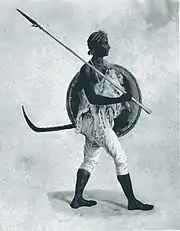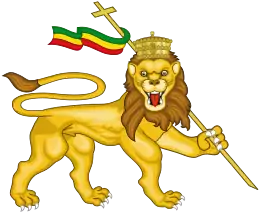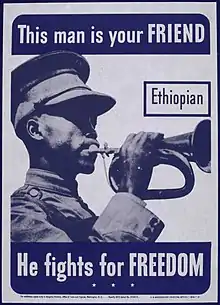Military history of Ethiopia
The military history of Ethiopia dates back to the foundation of early Ethiopian Kingdoms in 980 BC. Ethiopia has been involved many of the major conflicts in the horn of Africa, and was one of the few native African nations which remained independent during the Scramble for Africa, managing to create a modern army. 19th and 20th century Ethiopian Military history is characterized by conflicts with the Dervish State, Mahdist Sudan, Egypt, and Italy (which successfully annexed Ethiopia to Italian East Africa, until its liberation during WWII), and later by a civil war.

Part of a series on the |
|---|
| History of Ethiopia |
 |
First Italo–Abyssinian War (1895–1896)
From 1895 to 1896, the First Italian-Abyssinian War was fought between the Kingdom of Italy and the Ethiopian Empire (Abyssinia). Unlike most of Africa, Ethiopia was able to avoid being conquered by the European powers. In 1895, Italian armed forces invaded Ethiopia from Eritrea. But, because Ethiopia had established a single and incorporated army and broke ethnic barriers to unite, the Italian regular forces were decisively defeated within a year at the Battle of Adwa. Special role for this purpose was played by the Russian military advisers and volunteers of Menylik's army (for example Leonid Artamonov).[1][2][3][4]
Boundary confrontation against British Colonists (1896–1899)
After the successful colonial subjugation of the Sudan, Kenya and Uganda, the British started to apply pressure against Ethiopia, which subsided somewhat during The Second Boer War 1899–1902. The Ethiopian military gained valuable experience by dealing with British colonial forces (both military and not) in the course of trying to establish a well defined border. The fact that the Ethiopian military (and state) was organized enough to resist and the fact that it had diplomatic relations with a number of European states from which it could draw on for diplomatic support and arms sales gave pause to the surrounding European powers. Alexander Bulatovich (one of the Russian military advisers and participant of expedition of legendary army of Ras Wolde Giyorgis) wrote of the Ethiopian military- "Many consider the Abyssinian army to be undisciplined. They think that it is not in condition to withstand a serious fight with a well-organized European army, claiming that the recent war with Italy doesn't prove anything. I will not begin to guess the future, and will say only this. Over the course of four months, I watched this army closely. It is unique in the world. And I can bear witness to the fact that it is not quite so chaotic as it seems at first glance, and that on the contrary, it is profoundly disciplined, though in its own unique way. For every Abyssinian, war is the most usual business, and military skills and rules of army life in the field enter in the flesh and blood of each of them, just as do the main principles of tactics. On the march, each soldier knows how to arrange necessary comforts for himself and to spare his strength; but on the other hand, when necessary, he shows such endurance and is capable of action in conditions which are difficult even to imagine. You see remarkable expediency in all the actions and skills of this army; and each soldier has an amazingly intelligent attitude toward managing the mission of the battle. Despite such qualities, because of its impetuousness, it is much more difficult to control this army than a well-drilled European army, and I can only marvel at and admire the skill of its leaders and chiefs, of whom there is no shortage."[5]
Russia allowed a number of Ethiopians to attend several Russian military cadet schools. From 1901-1913, approximately 40 Ethiopian officers attended military training in Russia. Tekle Hawariat Tekle Mariyam, the future author of Ethiopia's constitution, was among those that attended.
In accordance with the order of emperor of Ethiopia, Nikolay Leontiev organized the first battalion of the regular Ethiopian army. It was presented to Menelik II, in February, 1899. This battalion formed the cadre around which the army was organized. The company of volunteers was then organised from the former Senegal shooters (disappointed or unreliable for colonial authorities), which he chose and invited from Western Africa. They were trained by Russian and French officers. The first Ethiopian military orchestra was organized at the same time.[6][7]
Second Italo-Abyssinian War
On October 3, 1935, Fascist Italy invaded the Ethiopian Empire from Italian Eritrea and Italian Somaliland. The Ethiopians used prohibited dumdum bullets and mutilated captured soldiers,[8] while the Italians used chemical weaponry in a number of battles.
The Second Italo-Abyssinian War, the Spanish Civil War, and the Mukden Incident are often seen as precursors to World War II, and a demonstration of the ineffectiveness of the League of Nations. In 1941, after years of occupation, Emperor Haile Selassie I returned to what was now called Italian East Africa. With the help of the British, the Emperor led an uprising to drive the Italian Army from his country after a guerrilla war.
World War II

During World War II, Ethiopia was under Italian occupation and part of the colony Italian East Africa. During the East African Campaign, with the help of British forces, Emperor Haile Selassie joined the resistance groups against the Italian Army. After some initial Italian offensive actions in 1940 (conquest of Kassala in Sudan and British Somalia), British and Commonwealth forces launched attacks from the Sudan and from Kenya. On 5 May 1941, the Emperor re-entered Addis Ababa. By the end of November, organized Italian resistance in East Africa ended with the fall of Gondar. However Italians maintained a guerrilla war, mainly in northern Ethiopia, until September 1943.
Korean War
Ethiopia sent 1,271–3,518 troops as part of the United Nation Forces to aid South Korea. The troops were known as the Kagnew Battalion under the command of General Mulugueta Bulli. It was attached to the American 7th Infantry Division, and fought in a number of engagements including the Battle of Pork Chop Hill.[9] 121 were killed and 536 wounded during the Korean War.
Derg Rule
In 1974, a military coup overthrew Emperor Haile Selassie and declared Ethiopia a republic. Between 1974 and 1984, a communist military junta called Derg ruled.
Ogaden War
Somalia invaded the Ogaden region and starting the Ogaden War. Fighting erupted as Somalia attempted a temporary shift in the regional balance of power in their favour by occupying the Ogaden region. The Soviet Union switched from supplying Somalia to supporting Ethiopia, which had previously been backed by the United States. The war ended when Somali forces retreated back across the border and a truce was declared. Ethiopia was able to defeat the Somali forces with the aid of the USSR, Cuba, and South Yemen. This was the first conflict in which the Mi-24 was used.
Civil War

The Ethiopian Civil War was a 17-year conflict between the Derg government backed by the USSR against anti-communist rebels backed by the United States. The conflict ended in 1991 with the Derg government defeated and out of power along with Eritrea gaining independence. The Eritrean insurgence that began in 1961 was helped by a nationwide Ethiopian guerrilla campaign of OLF, TPLF and ONLF against the Ethiopian Derg government. At the end of the Civil war, with the Eritrean and Ethiopian victory over the Derg government, Eritrea gained its independence from Ethiopia in 1991 following a referendum.
Eritrean-Ethiopian War
The Eritrean-Ethiopian War was a border clash that took place from May 1998 to June 2000.
Fighting escalated to artillery and tank fire leading to four weeks of intense fighting. Ground troops fought on three fronts. Eritrea claims Ethiopia launched air strikes against Eritrea's capital Asmara while Ethiopia accused Eritrea of striking first. The fighting led to massive internal displacement in both countries as civilians fled the war zone.
The conflict ended in stalemate and deployment of UNMEE.
Somalia
In 2006, Ethiopia deployed troops to aid the TFG in the ongoing Somali Civil War.[10] ENDF deployed troops in the northern region to aid the TFG and in the southern region with support from the United States Fifth Fleet. By January 2007 Ethiopian forces were about 200,000 troops. On November 2008 Ethiopia announced that they would be removing their troops, and all Ethiopian forces had left the country by January 15, 2009.
See also
References
- "Cossacks of the emperor Menelik II". Archived from the original on 2015-07-16. Retrieved 2012-02-10.
- Russian Mission to Abyssinia.
- Who Was Count Abai?.
- Leonid Artamonov, a Russian general, geographer and traveler, military adviser of Menelik II, as one of Russian officers of volunteers attached to the forces of Ras Tessema (wrote: Through Ethiopia to the White Nile).
- "- With the Armies of Menelik II by Alexander K. Bulatovich". Archived from the original on 2014-04-14. Retrieved 2010-07-22.
- Count Leontiev is spy or adventurer...
- Nikolay Stepanovich Leontiev
- Antonicelli 1975, p. 79.
- "Battle on Pork Chop Hill". Military History. Historynet.com. Archived from the original (on-line journal) on 9 November 2006. Retrieved 29 December 2006.
- "Ethiopian Troops Enter Somalia to Resist Islamic Militia". PBS. 2006-07-20. Retrieved 2007-01-05.